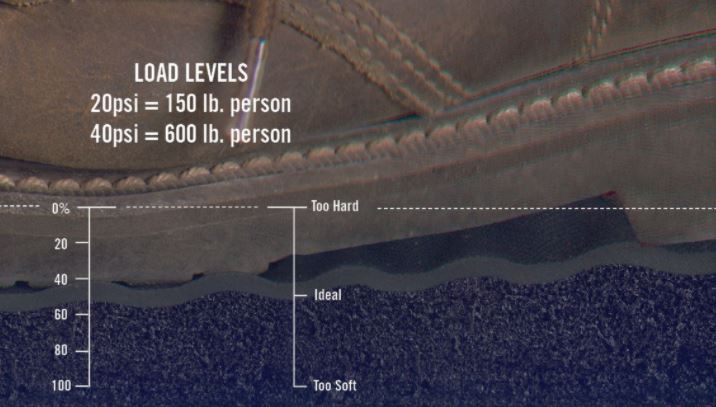There are several components to consider when choosing the best anti-fatigue solution for your environment. While some mats may initially feel great under your feet, that does not mean that they will provide good long-term benefits. You may step on a mat and think “this is so soft, and bouncy, I feel like I’m walking on air!” However, there is such a thing as “too soft” and ultra-soft material often compresses quickly and fails to provide any ergonomic benefits after a few months.
The measurement of a material’s resistance to force is called compression deflection while durometer is the measure of the hardness of the material.
To test the compression deflection of a mat, two specific load levels are applied to the mat and the result shows the deflection, or in other words, it shows how much the product “gives” when a load is applied. The load levels used are 20psi (equal to a 150-pound person), and 40psi (equal to a 600-pound person). Mats with less than 20% deflection are generally perceived as too hard, while mats with greater than 60% deflection are perceived as too soft. Mats that fall between 20% and 60% tend to provide the most comfort and produce the greatest anti-fatigue benefits.

The hardness of a mat's surface is measured by means of a Type A Shore Durometer. The durometer measures the penetration of a specified indenter forced into the test material under specified conditions. To simplify it, an indenter is pushed down into the product until firm contact is made, and that is where the reading is taken. Lower readings indicate softer materials and higher readings indicate harder materials.
It's important to understand that durometer is only a measure of hardness for the mat's surface, not the mat's overall hardness or softness.
Compression deflection is a much better measure of a mat's overall "comfort." You can access each mat's compression deflection in the specifications tab on each product detail page, however, we've also compiled them below for you. Keep in mind that 20 psi is representative of a 150-pound person and 60 psi is representative of a 600-pound person. Given that the average worker typically weighs 150 to 250 lbs, the 20 psi reading is probably the one you want to focus on, and you ideally want it to be somewhere between 20% and 60% for maximum anti-fatigue benefits.


